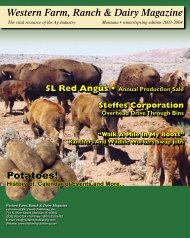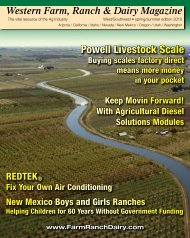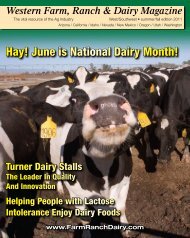Wisconsin Seed Potato Growers Offer Superior Spud Source
Wisconsin Seed Potato Growers Offer Superior Spud Source
Wisconsin Seed Potato Growers Offer Superior Spud Source
Create successful ePaper yourself
Turn your PDF publications into a flip-book with our unique Google optimized e-Paper software.
Colorado has a new Mesa<br />
The Mesa Russet <strong>Potato</strong><br />
New Russet Release from Colorado’s Cultivar Development Program.<br />
Article by Robert Davidson, David Holm and Samuel Essah.<br />
Colorado’s Cultivar Development Program has recently<br />
released a new russet cultivar, The Mesa<br />
Russet. (CO94035-15RU). The Mesa Russet produces<br />
a medium-high yield (418 cwt under SLV<br />
conditions) of very attractive, oblong to long, dark russet<br />
tubers. It produces a high percent of NO 1’s (86%) with approximately<br />
25% of the yield in the > 10 oz range. External and<br />
internal defects are minimal. The Mesa Russet is moderately<br />
resistant to hollow heart and second growth, blackspot bruise,<br />
and shatter bruise. While specific gravity is medium (1.082),<br />
this is a dual purpose potato suitable for both the fresh market<br />
and processing. Mesa Russet has upright, medium large vines<br />
that emerge quite uniformly with an average of 3 stems per<br />
plant. Vine maturity is medium at a 2.9 (Canela Russet = 3.1;<br />
Centennial Russet = 3.0). This cultivar has acceptable longterm<br />
storage characteristics (dormancy around 95 days after<br />
harvest, which is similar to Russet Nugget and Russet Norkotah,<br />
but shorter than Canela Russet) and growers have commented<br />
that late season storage has been quite good with tubers<br />
showing little to no blackspot and good appearance. Market<br />
acceptance has been quite good since the tubers have such an<br />
attractive appearance.<br />
Introducing Colorado’s New:<br />
Mesa Russet<br />
Like the Mesas of Colorado;<br />
Mesa Russet is a natural wonder of beauty<br />
Dual Purpose – Medium Maturity<br />
High total of number ones with Uniform tuber set<br />
Resistant to Powdery Scab – Good Resistance to Verticillium Wilt<br />
Moderately resistant to Hollow Heart,<br />
Second Growth, Blackspot and Shatter Bruise<br />
Extremely low levels of Root Galling – Strong Vines<br />
COLORADO CERTIFIED POTATO GROWERS ASSOCIATION<br />
P.O. Box 267 • Monte Vista, CO 81144 • (719)274-5996<br />
www.coloradopotato.org/seed<br />
Work completed at the SLV Research Center indicates that the<br />
Mesa Russet requires a 12 to 14” spacing in the field to produce<br />
the best yields (12” spacing maximizes the 4-10 oz range while<br />
14” spacing maximizes the 10-16 oz range). Total nitrogen applications<br />
should be in the 180# /a area with 80# / a pre-plant and<br />
the balance applied prior to the end of July in 3 to 4 increments<br />
after tuber initiation. Irrigation management is similar to the Rio<br />
Grande Russet. Disease issues have been minimal to date. While<br />
the cultivar is susceptible to both leaf roll and PVY, there have<br />
been few problems seen in the crop, even when grown quite late<br />
into the season. This cultivar is of note because of its extremely<br />
low powdery scab susceptibility; both with any tuber symptoms<br />
and with a very low root galling index. This could be of help in<br />
reducing or minimizing the impact from powdery scab during<br />
your rotation cycles with potatoes. It has shown excellent resistance<br />
to Verticillium Wilt. <strong>Growers</strong> have commented that the<br />
Mesa Russet tends to fit into their operation quite nicely as a medium<br />
maturing cultivar with few tuber defects.<br />
The Mesa Russet provides another high quality russet to put<br />
into your grower’s toolbox of cultivars. It should perform well<br />
in a variety of environmental conditions and should be of help<br />
in maintaining a profitable crop.<br />
e<br />
POTATO SUNBURN?<br />
(Here’s a solution from Northwest Tillers.)<br />
• Problem: Sunburned potatoes<br />
• Cause: <strong>Potato</strong> exposure after defoliation<br />
• Solution: Re-cover exposed potatoes with soil<br />
• Method: Our reverse-drive tiller moves soil<br />
from the furrow over the hills without harming the<br />
potatoes, using controllable depth from 1/2 to 2<br />
inches with Northwest’s exclusive “Deep Reach”<br />
rotors and blades.<br />
Problems start to occur when plant foliage is<br />
removed before harvest and potatoes near the<br />
surface or above the ground are no longer shaded.<br />
The fields can dry out before the harvest and the<br />
soil can crack as it dries, exposing the potatoes to<br />
further sunlight.<br />
Northwest’s <strong>Potato</strong> Sunburn-Prevention Tiller<br />
gently re-covers the potato hill with a sunblocking<br />
layer of soil, eliminating furrow clods and saving<br />
crop loss from sunburn and maximizing your farm’s<br />
packout.<br />
Northwest Tillers, Inc.<br />
3715 West Washington Avenue<br />
Yakima, WA 98903<br />
(800) 204-3122<br />
www.nwtiller.com<br />
www.farmranchdairy.com Rocky Mountain/Heartland Western Farm, Ranch and Dairy • 7
















